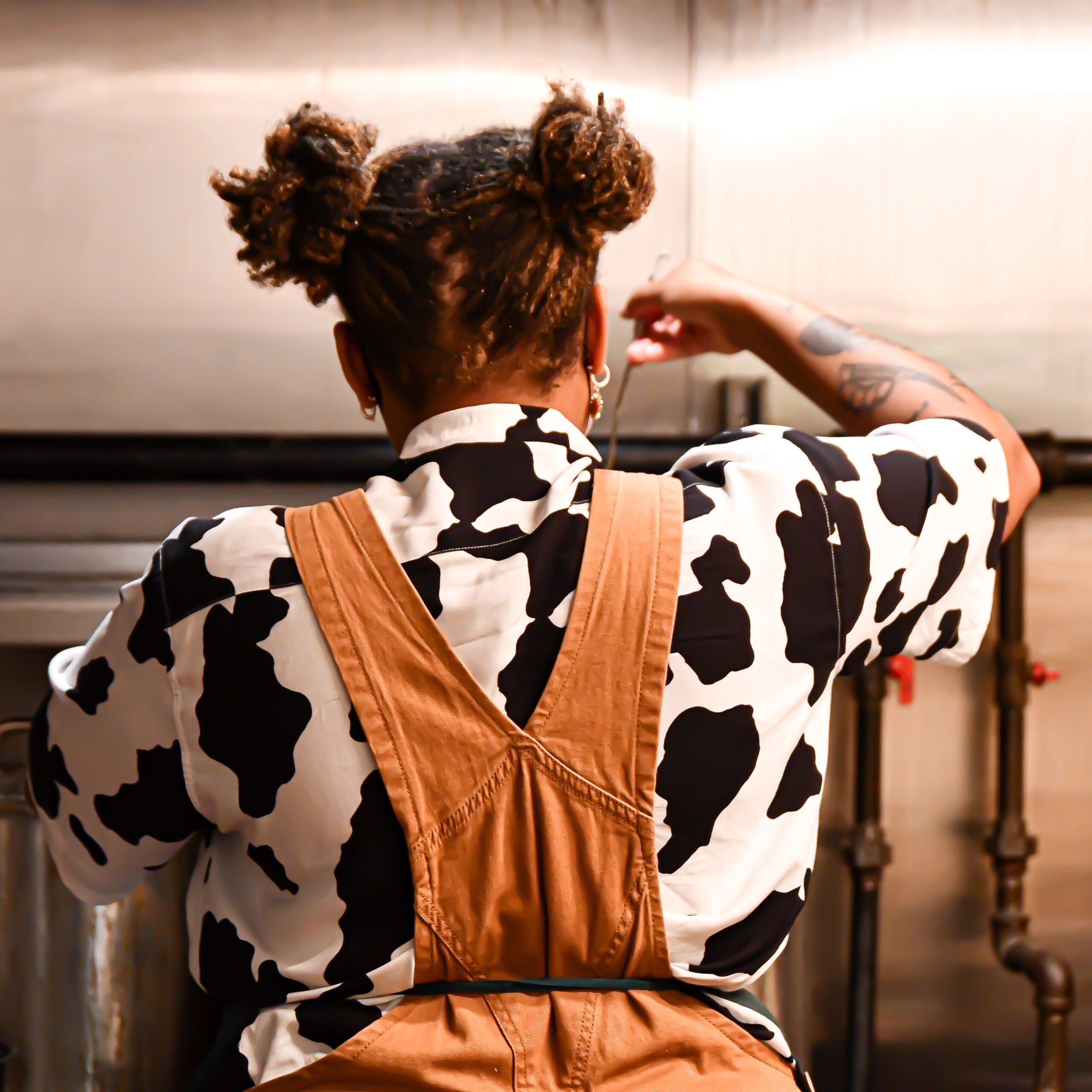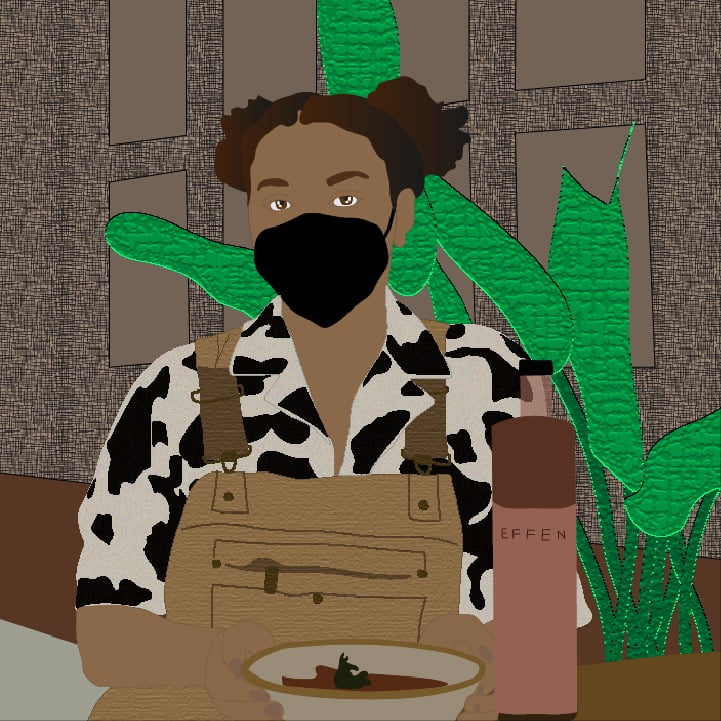By: Emily Bunn
This Women’s History Month, 360 Magazine sat down with Chef Kia Damon. Kia is the founder of Kia Feeds The People (KFTTP) and is a cofounder of Auxilio, both of which are non-profits aimed at combating food apartheid. We dished with Kia on how she discovered her passion for cooking, pathways towards increased Black and QTPOC representation in the culinary industry, and her upcoming video release with EFFEN Vodka and Queer Foods, which can be viewed here.
When did you first begin cooking? When did you realize you wanted to pursue it professionally?
“I started cooking in my early preteens. I have younger brothers as well, so once we were too old for day care, I had to step up as the older sibling to make sure we ate, especially more so during the summertime because I have working parents. But, it wasn’t until some years later when I started cooking independently for my own health reasons that I truly saw my strengths in cooking and realized that cooking professionally wasn’t a world that was so far away for me, that it was actually extremely attainable and extremely real. So I took the plunge, and to this day some of my family’s still very surprised, because I was definitely burning pots of rice, and they were like ‘this girl has no talents for the kitchen.’ Now I’m cooking and they still can’t believe it.”
We all know foods brings communities together. Are there any experiences you’ve had with community members through Kia Feeds The People that have stuck with you?
“Yes! Honestly, the most connective part was before I even started cooking with KFTTP people when I was looking for guidance from a lot of my friends in the cooking community. Because KFTTP was birthed in a really tumultuous time, I felt like I couldn’t quite gather my thoughts and my feelings. I just felt so emotionally charged and stunted that I felt like I couldn’t even work or think or move because I felt so emotional about everything. But being able to lean into my friends and my chosen family who see me for who I am, who know me intimately and know my heart, they were able to guide me to where I am now and toward my mission for KFTTP. I’m super grateful. These are people that I’ve been able to cook with before, these are people that I’ve literally eaten with before–we’ve shared food out of deli containers at 3am–I’m very grateful for them. And I definitely could not have got to this place without them.”
Are you looking to expand KFTPP outside of Brooklyn, or just focus on this specific community?
“Because I am a Sagittarius, I definitely am looking to expand and looking to grow. I definitely have to make sure I build and flesh KFTTP out as much as possible in Brooklyn before I start thinking about moving other places. But I do have visions, not necessarily to just expand Kia Feeds The People, but to collaborate with other mutual aid organizations and non-profits that already exist in other cities, so that I can support them and [they] have more coverage where they are. I’m not the only one who’s doing this kind of work and it is definitely a collaborative, lifelong mission, so I want to lend hands to the people who are already in this game.”
What do you think is the biggest obstacle facing overcoming food apartheid?
“Personally I think the biggest obstacle is still convincing people that it exists, because we live in such a individualistic world. If something doesn’t affect the next person, then they’re more likely to ignore it, you know. That’s why I think COVID really shook things up, because a lot of us were collectively put on our butts. you know. We’re like “whoa, wait a minute, is this one thing that is really proactively affecting us.” But regarding food apartheid, a lot of people are still familiar with it in terms of a “food desert.” Food desert is a word that’s been used for many years to describe this situation, and a “desert” implies that it is natural, because the world naturally created deserts. When you apply “food desert” to that idea, it implies that this place without food, this place without access to meals, is natural and that’s just the way that it’s supposed to be. But it’s completely unnatural, it’s completely systematic, and [after recognizing that] then we can start looking at it as something that is created by is created by systems. Then, we can put some realness to it and find how all of us are truly affected by them. So I think right now, it’s making sure people know what food apartheid is, and that it actually exists.”
Do you have a favorite meal or cocktail to prepare when you’re bringing family or friends together?
“My favorite meal is red beans and rice. I love a good pot of Louisiana-style red beans and rice, because honestly that–with some corn bread on top and so hot sauce– that really is the whole meal. You think you would need something else on the side but that’s really it. It’s so fulfilling, it’s so delicious, and I definitely try to bring it out when I get to be with my friends and family.”
The culinary world is a male-dominated industry. How can the culinary industry work to become more diverse, and have more Black, QTPOC chefs?
“I think it’s a starts with actually investing in the lives and careers of these black/brown/trans/ LGBTQ chefs because they exist. I know they exist because they’re my friends. And what happens is that maybe they’re put in positions of leadership or maybe not, but they’re they’re not given the same care, support or investment in their skills and education and their needs. You could put someone in a line chef position or position of leadership or whatever, but if there’s no follow through to make sure that they have what they need to be supported in those positions, they’re usually set up for failure, or set up to be harmed in some way. Or maybe a small business that’s LGBTQ or Black has a good profile, [but they may not be] getting access to grants or money. You have to have the follow through. It’s not that we don’t exist, it’s that we’re not properly supported when we are put at the forefront. That’s when it gets tricky and that’s when we’re left open to harm and failure.”
What are you most excited about regarding this video release with Queer Foods and EFFEN Vodka?
“I’m very excited for mom to see it first of all, I love my mommy and she is my number one fan. And she’s a Gemini, so I’m always looking for her approval. But I’m also excited to get to Kia Feeds The People and Queer Stories in front of the world. I feel like we can’t tell enough queer stories, there’s always someone’s story out there. Even though there’s this myth out there that there’s already enough representation, or that maybe it’s too much to keep talking about queer people, that’s actually far from the truth. I’m proud and honored that EFFEN Vodka wants to support what I’m doing and wants to get my story out there. My story is the story of a lot of other Black and brown and trans people’s stories, and it also feels good to partner with someone who sees me and wants to invest in my story and invest in supporting other diverse artists, both in their representation and practice. It just feels good to be seen, and I’m excited for everyone else to see me and to be seen. Just look! Everyone just look! I want everyone to look and feel pride in who we are.”
How can readers donate to Kia Feeds The People?
“You can head to my GoFundMe if you’re not in the city, or if you’re in Brooklyn you can come to a pop up. Please donate to my GoFundMe, I have it on my Instagram page. Share it with your friends, let them know what’s up. Or if you are in Bed-Stuy, you can find me at a pop-up– I have a few coming up in April, so I’m going to be all over the place. Come get some food or throw some money, either way I’ll be very grateful.”
To learn more about Kia, visit her website.
Kia’s EFFEN Rosé Vodka Grapefruit Cocktail
Ingredients:
- 2 parts EFFEN Rosé vodka
- 1 oz of lime juice
- ½ oz of cane syrup
- 2 or 3 parts grapefruit juice
Mix the grapefruit juice, lime juice, simple syrup, EFFEN Rosé vodka and a spoonful of ice in a cocktail shaker. Stir and taste. Strain into a chilled martini glass and garnish with grapefruit, and thyme. Drink responsibly + enjoy!
Kia’s Gumbo Recipe
Ingredients
- 8 oz andouille sausage
- 1lb Boneless skinless chicken thighs
- 2 large yellow onions, diced
- 4 stalks of celery, diced
- 2 green bell peppers, diced
- 2 cups sliced okra, fresh or frozen
- 3 cloves of garlic, minced
- 1 cup of oil
- 1 cup AP flour
- 6 cups chicken stock
- 4 tbsp Creole seasoning
- 1 tbsp of fresh thyme
- 1 tbsp Smoked paprika
- ½ tbsp Ground sage
- 1 tbsp Worcestershire sauce
- Hot sauce to taste
- Black pepper
- Kosher salt
- Fresh parsley
Directions
- Season the chicken thighs with 2 tablespoons of creole seasoning, salt and pepper. Season well on both sides. Heat a skillet or cast iron to medium heat with enough oil to cover the bottom. When the pan is hot, sear the chicken in batches. Brown the chicken on both sides and set aside. The chicken does not have to be cooked through just yet.
- In a large pot add the oil and heat to a medium high heat. Add the flour and whisk until it begins to cook. Lower the heat to medium low. Keep whisking the roux over a controlled and steady heat until the flour begins to darken into a deep brown. This takes about 30 minutes, so pace yourself.
- Turn the heat down on the roux and add in your onion, bell pepper and celery. Stir into the roux, season with a few pinches of salt and sauté until fragrant and translucent. Add in your minced garlic and fresh thyme. Stir for another 2 minutes. Slowly pour in the chicken stock while whisking the roux. Do this part slowly because the roux will begin to thicken. Take your time and continue pouring in the stock until it’s completely incorporated.
- Bring the pot to a boil, meanwhile slice the sausage in ¼ inch rounds on a slight bias. When the pot begins to boil, reduce to a simmer and add the chicken and sausage. Let the gumbo cook on low for an hour. You want time for the flour taste to cook out.
- After an hour, add the remaining two tablespoons of creole seasoning, smoked paprika, ground sage and Worcestershire sauce to the pot. Stir and add your sliced okra. Cook for another 10 minutes, add salt and pepper and hot sauce to taste then serve with rice and chopped parsley.
- Enjoy!

Photo credit: Solène Michel Recipe credit: Kia Damon, Kia Feeds The People

Photo Credit: Solène Michel






